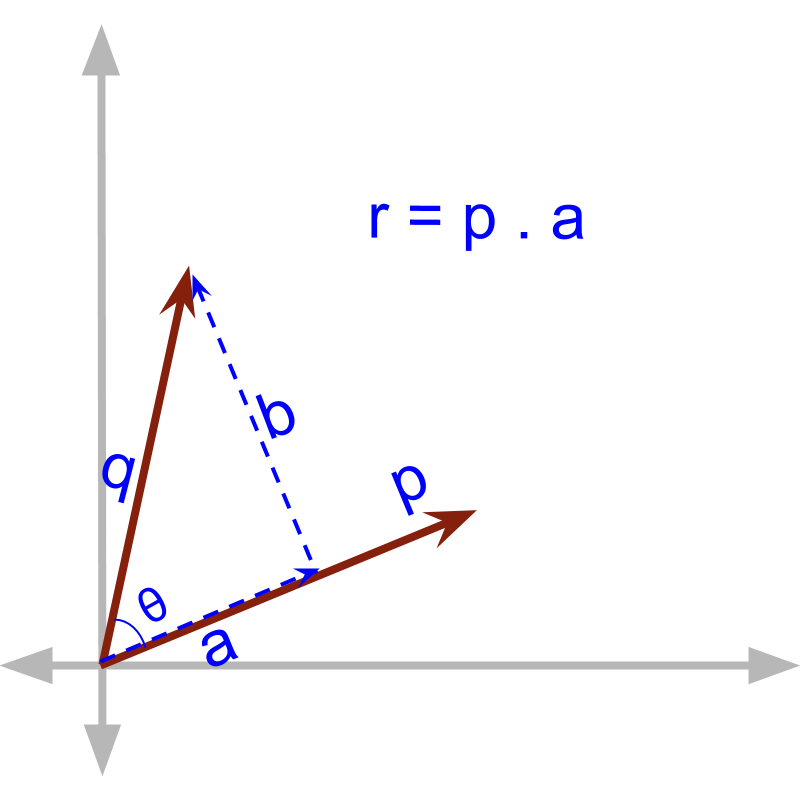
what you'll learn...
Overview
Vector Dot Product: First Principles
» multiplied with component in parallel
 →
→
→ product of magnitudes of components in parallel
in parallel
We have developed the understanding that
• In some application scenarios, effect will be in the same direction as that of the cause.
• the observed effect can be sum of the effects of multiple different causes.

A vector can be split into components in parallel and in perpendicular directions to another vector.
Consider that force is acting on an object which moves displacement . The effect is split into components and , where is in the same direction as the cause . The work done by cause is ' multiplied by ' as the effect is in the same direction and in that direction no other cause is observed.

Generalizing that... For two vectors and , the vector dot product of the vectors is given by multiplication of
• magnitude of one vector and
• the magnitude of the component of second vector in parallel to the first vector.
where is the component of in the direction of .

The component can be computed as '', using basic trigonometry.
This product is formally defined as vector dot product.
Note that the result is a scalar. So, this operation is also called Scalar Product of vectors.
A vector multiplication for components in parallel (in the same direction) is defined as scalar product or dot product.
The component in perpendicular does not take part in the dot product. This product of vector models application with the cause-effect relations that always in the same direction.
When two vector quantities interact to form a product, either one of the (1) component in parallel or (2) component in perpendicular is involved in the multiplication.
A vector multiplication for components in perpendicular is defined as cross product. This is explained later.
examples
Two vectors and with magnitudes and respectively are at an angle . What is ?
Vector with magnitudes and are in the opposite directions. What is the dot product of these two vectors?
The answer is ''. The angle between the vectors is and .
A vector of magnitude is the cause. The observed effect is of magnitude at an angle to the . What is the product between them?
The answer is ''. Product between cause and effect is vector dot product .
summary

Vector Dot Product / Scalar Product : is defined as
where is the angle between and .
It is the product of components in parallel (i.e. in the same direction).
Outline
The outline of material to learn vector-algebra is as follows.
Note: Click here for detailed outline of vector-algebra.
• Introduction to Vectors
→ Introducing Vectors
→ Representation of Vectors
• Basic Properties of Vectors
→ Magnitude of Vectors
→ Types of Vectors
→ Properties of Magnitude
• Vectors & Coordinate Geometry
→ Vectors & Coordinate Geometry
→ Position Vector of a point
→ Directional Cosine
• Role of Direction in Vector Arithmetics
→ Vector Arithmetics
→ Understanding Direction of Vectors
• Vector Addition
→ Vector Additin : First Principles
→ Vector Addition : Component Form
→ Triangular Law
→ Parallelogram Law
• Multiplication of Vector by Scalar
→ Scalar Multiplication
→ Standard Unit Vectors
→ Vector as Sum of Vectors
→ Vector Component Form
• Vector Dot Product
→ Introduction to Vector Multiplication
→ Cause-Effect-Relation
→ Dot Product : First Principles
→ Dot Product : Projection Form
→ Dot Product : Component Form
→ Dot Product With Direction
• Vector Cross Product
→ Vector Multiplication : Cross Product
→ Cross Product : First Principles
→ Cross Product : Area of Parallelogram
→ Cross Product : Component Form
→ Cross Product : Direction Removed